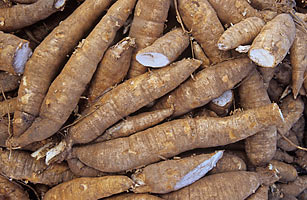Post-Harvest loss Reduction (Cassava Processing)
Cassava (manihot esculentile crants) is a starchy root crop. Best known to Americans as tapioca. The crop can have deadly consequences. If prepared incorrectly, the cassava plant can produce cyanide, a deadly compound when consumed. It is known as the anti famine crop in africa , as no nation in the continent that extensively cultivates this crop has experienced widespread famine in recent years. Its a major food staple in Cameroon and its value cannot be over emphasised in terms of food security and even employment. Therefore proper post harvest handling and processing are necesary for enhanced utilization of the crop. Now let us illustrate how cassava can be processed into numerous products that expand shelf life and reduce post harvest loss. Current Good Manufacturing Practises (CGMP) and Standard Operationg Procedures (SOP) like environmental hygeine etc are key in processing.
CASSAVA FLOUR
This can be used in the production of some backed and fried products such as sausages, cookies, bread and cakes, biscuits, noodles, ice-cream cones. It can be substituted at different ratios to give cassava/wheat composite flour
Procedure.
- Select Fresh Cassava roots
- Sorting
- Washing
- Peeling
- Grating
- Dewatering in Hessian or polypropylene sack
- Pulverizing
- Drying
- Milling and
- Packaging
I intentionally left out the process for making “Garri” and “Waterfufu” (Akpu in Nigeria) or “KumKum” (Lafu or Amala in Nigeria) which are common cassava made local meals in Cameroon. Of course, these too are a great remedy to post-harvest loss.
CASSAVA STARCH
This is the next big most valuable processed product from cassava. It is very relevant in the pharmaceutical, textile, paper and food industries. salad cream and cassava starch burns
Procedure
- Selection and sorting of fresh cassava
- Peeling
- Grating
- Mixing with clean water 10times that of the root by weight
- filtering (muslin cloth/0.5-1mm sieves)
- Settling or sedimenting
- Decanting
- Starch washing 3 or more times
- Settling or dewatering in clean bag and pressing
- Drying thinly spread in the sun or mechanical dryer
- milling
- packaging
Take note, value addition is key in post-harvest waste reduction and achieving food security. We can be hunger-free.
